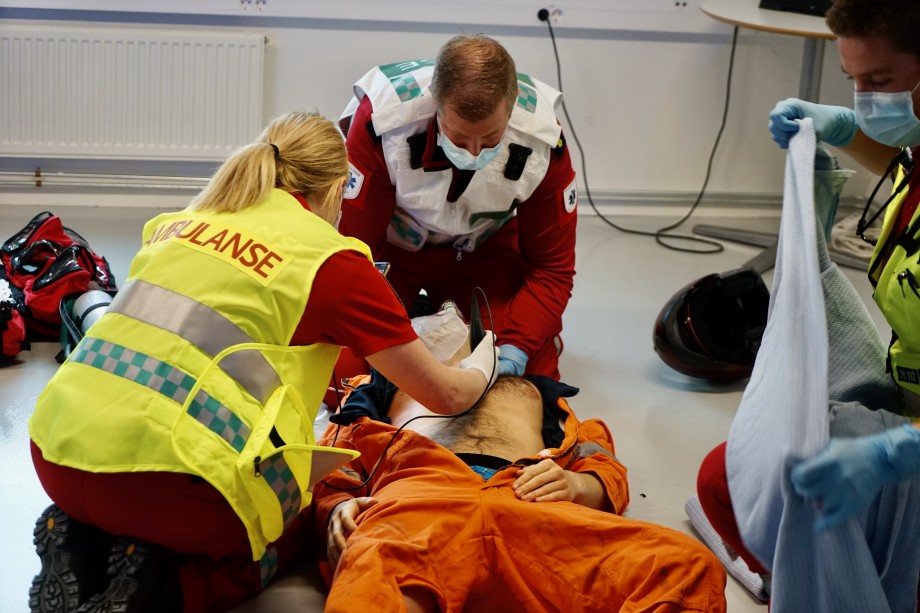How can we organize ultrasound training in a pandemic situation and across national borders? Researchers at the University of Stavanger will be testing a remote solution this autumn.

First published September 29, 2020. Text: Cathrine Sneberg
Ultrasound is a medical imaging tool that historically has been restricted to medical specialists such as radiologists and cardiologists. In recent years, however, its use has been implemented into various health disciplines, and many universities and teaching institutions are integrating ultrasound into the curriculum of relevant studies.
– One clinical application for medical ultrasound is found in the prehospital setting. Ultrasound machines are now available as pocket-sized hand-held devices, making it easy and convenient to bring in an ambulance or to the patient's bedside, says Victoria Vatsvåg.
She is a trained radiographer with a master's degree in ultrasound. She is currently also a research fellow at the Faculty of Health Sciences at the University of Stavanger.
– At the same time, it is a new ability that must be learned and maintained, in addition to other skills required to work in prehospital services, she adds quickly.
The acquisition and interpretation of ultrasound examinations are highly user-dependent. In addition to lack of experienced users, available trainers and proper training curricula are some of the main barriers to this technology's widespread use.
Can provide a better basis for decision-making in the field
At the University of Stavanger, the Master's program in Prehospital Critical Care has embedded ultrasound in its curriculum. The course emphasizes basic techniques for efficient and safe use of ultrasound in emergency medicine, increasing patient safety, and providing a better basis for decision-making in the field.
Due to the spread of Covid-19, there is significant uncertainty for all teaching institutions regarding how best to teach and still adhere to the ever-changing rules and restrictions given by the National Institute of Public Health. With the negative trend seen in many European countries, Norway included, universities are trying their best to offer students teaching on digital platforms when possible.
– Several ultrasound devices now come with integrated telecommunication solutions and with interfaces optimized for remote guidance. We consider this a solution to the problems we face trying to organize this year's ultrasound course, says Vatsvåg.
Vatsvåg is responsible for the course this autumn, and fortunately, she has extensive experience from providing ultrasound training via video conference to healthcare professionals who work offshore.
Telementored ultrasound
Connecting experts to novice ultrasound users, in this case, students with little or no ultrasound experience, is often referred to as telementored ultrasound. The method is widely described in the literature. There are, however, few studies exploring the efficiency of this teaching method.
– We consider this forced situation the perfect timing for conducting a study exploring just this, Vatsvåg adds.
The study will have two comparable groups of novice ultrasound users. Students from the master's program in prehospital critical care will receive remote training during the autumn, and a majority of the students will receive the necessary equipment by post. Vatsvåg will also recruit students from other health-related programs at the university to standard training on campus. They will hopefully be able to receive training during the spring of 2021.
Is remote training as effective as on campus?
– This study is attempting to show that the efficiency of telementored ultrasound training is not unacceptably worse compared to traditional classroom training, she says.
Both groups will receive online e-learning well in advance of the training day with the expert. On the day of practical training, both groups will be given summary lectures on topics such as ultrasound examination of the heart, detection of a punctured lung, and test for bleeding after trauma. One group digitally and the other one in a classroom.
– Following each lecture, the students will be guided through hands-on scanning. The students in the telementored group will need to recruit a volunteer scanning model, Vatsvåg points out.
Students in both groups will do a pre-test after completing the e-learning, and a post-test will take place between 1-3 days after completing their practical training. They are tested in theoretical and practical skills to uncover their ability to acquire, interpret, and initiate findings in the clinical context.

Brings the hospital closer to the patients
– We consider this to be a highly relevant study with regards to the current pandemic situation. Universities are working hard to adapt their teaching to be given online, and we present a study that is well suited for this, Vatsvåg explains.
Her doctoral project addresses just that; quality, implementation, and benefits of telementored ultrasound training and clinical examinations.
– A positive outcome of this study could impact how we deliver ultrasound courses in the future. Telementored ultrasound training could be of great benefit, not just for the students in this pandemic situation but for all relevant health personnel who work in remote settings with limited access to educated trainers, she concludes.
Because the overall goal of increased competence in ultrasound is to bring the specialist health services closer to patients far from hospitals, thus ensuring better and safer services to the population.